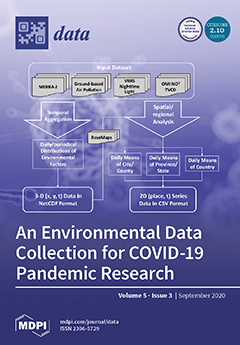Open AccessData Descriptor
A Multi-Annotator Survey of Sub-km Craters on Mars
by
Alistair Francis, Jonathan Brown, Thomas Cameron, Reuben Crawford Clarke, Romilly Dodd, Jennifer Hurdle, Matthew Neave, Jasmine Nowakowska, Viran Patel, Arianne Puttock, Oliver Redmond, Aaron Ruban, Damien Ruban, Meg Savage, Wiggert Vermeer, Alice Whelan, Panagiotis Sidiropoulos and Jan-Peter Muller
Cited by 7 | Viewed by 4802
Abstract
We present here a dataset of nearly 5000 small craters across roughly 1700 km
2 of the Martian surface, in the MC-11 East quadrangle. The dataset covers twelve 2000-by-2000 pixel Context Camera images, each of which is comprehensively labelled by six annotators, whose
[...] Read more.
We present here a dataset of nearly 5000 small craters across roughly 1700 km
2 of the Martian surface, in the MC-11 East quadrangle. The dataset covers twelve 2000-by-2000 pixel Context Camera images, each of which is comprehensively labelled by six annotators, whose results are combined using agglomerative clustering. Crater size-frequency distributions are centrally important to the estimation of planetary surface ages, in lieu of in-situ sampling. Older surfaces are exposed to meteoritic impactors for longer and, thus, are more densely cratered. However, whilst populations of larger craters are well understood, the processes governing the production and erosion of small (sub-km) craters are more poorly constrained. We argue that, by surveying larger numbers of small craters, the planetary science community can reduce some of the current uncertainties regarding their production and erosion rates. To this end, many have sought to use state-of-the-art object detection techniques utilising Deep Learning, which—although powerful—require very large amounts of labelled training data to perform optimally. This survey gives researchers a large dataset to analyse small crater statistics over MC-11 East, and allows them to better train and validate their crater detection algorithms. The collection of these data also demonstrates a multi-annotator method for the labelling of many small objects, which produces an estimated confidence score for each annotation and annotator.
Full article
►▼
Show Figures





